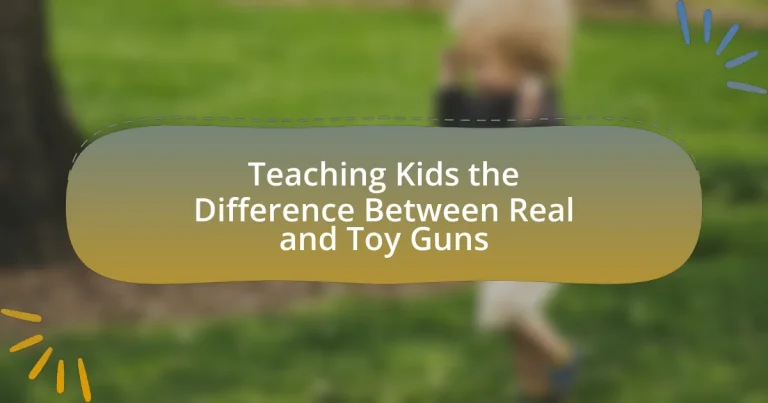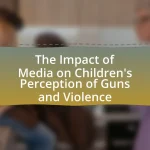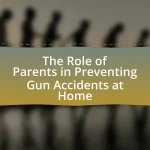Teaching kids the difference between real and toy guns is essential for their safety and understanding of firearms. This article emphasizes the importance of educating children about the potential dangers associated with real guns, the risks of misidentifying toy guns, and the impact of cultural attitudes and media representations on their perceptions. It outlines effective methods for parents and educators to communicate these distinctions, including age-appropriate discussions, role-playing scenarios, and the use of educational resources. Additionally, the article addresses common misconceptions about toy guns and provides practical tips for reinforcing gun safety lessons, ensuring children develop responsible behaviors around firearms.

What is the importance of teaching kids the difference between real and toy guns?
Teaching kids the difference between real and toy guns is crucial for their safety and understanding of firearms. This distinction helps prevent accidental injuries or fatalities, as children may not recognize the dangers associated with real guns. According to the Centers for Disease Control and Prevention (CDC), unintentional firearm injuries are a leading cause of death among children, highlighting the need for education on this topic. By teaching children to identify real firearms and understand their potential harm, parents and educators can foster responsible behavior and reduce the risk of tragic accidents.
Why is it crucial for children to understand this difference?
It is crucial for children to understand the difference between real and toy guns to ensure their safety and the safety of others. Misidentifying a toy gun as a real weapon can lead to dangerous situations, including accidental shootings or police interventions. According to a study published in the journal “Pediatrics,” children who cannot distinguish between real and toy guns are at a higher risk of injury or death in gun-related incidents. Educating children about this difference fosters responsible behavior and helps them navigate situations involving firearms more safely.
What potential dangers arise from confusion between real and toy guns?
Confusion between real and toy guns poses significant dangers, including accidental shootings, increased risk of violence, and legal repercussions. Accidental shootings can occur when individuals, particularly children, misidentify a toy gun as a real firearm, leading to tragic outcomes; for instance, studies have shown that in the United States, there have been numerous incidents where children were shot by law enforcement due to misinterpretation of toy guns as threats. Additionally, the presence of toy guns can normalize gun violence, potentially leading to aggressive behavior in children. Legal repercussions may arise when individuals brandish toy guns in public, as law enforcement may respond with lethal force under the assumption that they are facing a real threat. These factors underscore the critical need for clear distinctions between real and toy firearms to ensure safety and prevent harm.
How can misunderstandings impact children’s behavior and safety?
Misunderstandings can significantly impact children’s behavior and safety by leading to confusion about the nature of objects, such as distinguishing between real and toy guns. When children cannot accurately identify a toy gun as non-threatening, they may engage in risky behaviors, such as pointing it at others or using it inappropriately, which can escalate into dangerous situations. Research indicates that children often mimic behaviors they observe, and if they misunderstand the context of a toy gun, they may inadvertently provoke fear or aggression in peers or adults, potentially resulting in harmful consequences. For instance, a study published in the journal “Pediatrics” highlights that misinterpretations of toy weapons can lead to police involvement or accidents, emphasizing the critical need for clear communication and education regarding the differences between real and toy firearms.
What age is appropriate to start teaching this distinction?
The appropriate age to start teaching children the distinction between real and toy guns is typically around 4 to 5 years old. At this age, children begin to develop cognitive skills that allow them to understand basic safety concepts and the differences between real and pretend objects. Research indicates that early education on this topic can significantly reduce the risk of accidents involving firearms, as children who receive such instruction are more likely to recognize the dangers associated with real guns.
How does a child’s developmental stage influence their understanding?
A child’s developmental stage significantly influences their understanding by shaping their cognitive abilities, emotional responses, and social interactions. For instance, younger children in the preoperational stage, as defined by Piaget, may struggle to differentiate between reality and fantasy, making it challenging for them to grasp the serious implications of using real versus toy guns. In contrast, older children in the concrete operational stage can better understand the consequences of their actions and the distinctions between real and toy objects. Research indicates that children aged 5 to 7 often engage in imaginative play without fully comprehending the dangers associated with real weapons, while those aged 8 and above begin to develop a more nuanced understanding of safety and responsibility. This developmental progression underscores the importance of age-appropriate discussions and education regarding the differences between real and toy guns.
What signs indicate a child is ready to learn about gun safety?
A child is ready to learn about gun safety when they demonstrate an understanding of basic safety rules and show curiosity about firearms. Signs include the ability to follow simple instructions, ask questions about guns, and express an interest in understanding their dangers. Research indicates that children as young as four can grasp basic safety concepts when presented appropriately, as noted in studies by the American Academy of Pediatrics, which emphasize the importance of age-appropriate discussions about firearm safety.
What methods can be used to teach kids about real and toy guns?
To teach kids about real and toy guns, parents and educators can use methods such as direct education, role-playing scenarios, and visual aids. Direct education involves explaining the differences in appearance, function, and potential dangers of real guns compared to toy guns, emphasizing that real guns can cause serious harm. Role-playing scenarios allow children to practice responding to situations involving guns, reinforcing safe behaviors and decision-making. Visual aids, such as pictures or videos, can help illustrate the distinctions between real and toy guns, making the learning process more engaging and memorable. These methods are effective as they provide clear, practical understanding and promote safety awareness among children.
How can parents effectively communicate the differences?
Parents can effectively communicate the differences between real and toy guns by using clear, age-appropriate language and visual aids. Engaging in open discussions about the characteristics of each type, such as weight, appearance, and functionality, helps children understand the distinctions. For instance, parents can show a real gun and a toy gun side by side, highlighting differences in materials and mechanisms. Research indicates that children learn better through visual comparisons and hands-on experiences, reinforcing the importance of direct demonstrations. Additionally, parents should emphasize safety rules and the serious implications of using real guns, which can be supported by statistics showing that unintentional shootings often involve children mistaking real firearms for toys.
What role do educational resources play in this teaching process?
Educational resources play a crucial role in the teaching process by providing essential information and tools that facilitate understanding and engagement. In the context of teaching kids the difference between real and toy guns, these resources can include visual aids, interactive activities, and educational literature that clarify the distinctions between the two. For instance, studies have shown that using visual comparisons can significantly enhance children’s ability to identify real versus toy firearms, thereby promoting safety awareness. Additionally, resources such as workshops or guided discussions can foster critical thinking and help children articulate their understanding of the potential dangers associated with real guns compared to the playfulness of toy guns.
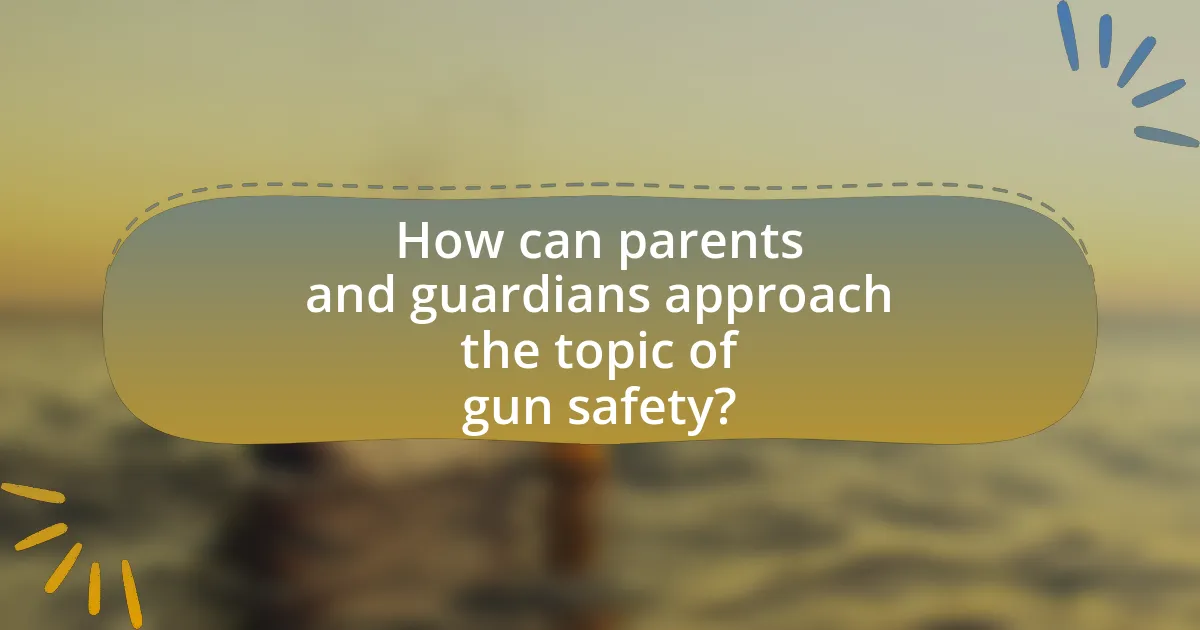
How can parents and guardians approach the topic of gun safety?
Parents and guardians can approach the topic of gun safety by initiating open and honest conversations with their children about the dangers associated with firearms. This involves explaining the differences between real guns and toy guns, emphasizing that real guns can cause serious harm or death, while toy guns are designed for play and should never be treated as real weapons.
To reinforce this understanding, parents can use educational resources, such as the National Rifle Association’s Eddie Eagle GunSafe Program, which teaches children what to do if they encounter a gun: stop, don’t touch, run away, and tell an adult. Additionally, parents should model safe behavior around firearms, including secure storage practices and never displaying guns in a way that could be perceived as normal or acceptable. By fostering an environment of safety and awareness, parents can effectively educate their children on the importance of gun safety.
What conversations should parents initiate with their children?
Parents should initiate conversations about the differences between real guns and toy guns to ensure their children understand the potential dangers associated with firearms. Discussing the importance of safety, the consequences of misusing toy guns, and the seriousness of real guns can help children develop a responsible attitude towards firearms. Research indicates that children who receive clear guidance on this topic are less likely to engage in risky behavior involving guns, as highlighted in studies by the American Academy of Pediatrics, which emphasize the need for open dialogue about gun safety in homes with firearms.
How can parents create a safe environment for these discussions?
Parents can create a safe environment for discussions about the differences between real and toy guns by fostering open communication and establishing trust. This involves actively listening to children’s concerns and questions, ensuring they feel comfortable expressing their thoughts without fear of judgment. Research indicates that children are more likely to engage in meaningful conversations when they perceive their parents as approachable and supportive (American Psychological Association, 2019). Additionally, parents should set clear boundaries regarding the topic, explaining the importance of safety and responsible behavior around firearms. By modeling calm and respectful dialogue, parents can reinforce the idea that these discussions are important and necessary for understanding the potential dangers associated with real guns compared to toy versions.
What questions should parents ask to gauge their child’s understanding?
Parents should ask their child questions such as, “Can you explain what makes a real gun different from a toy gun?” This question encourages the child to articulate their understanding of the physical and functional differences between the two types of guns. Additionally, parents can ask, “What do you think are the dangers of real guns compared to toy guns?” This prompts the child to consider the safety implications and the seriousness of real firearms. Another effective question is, “How would you react if you saw someone with a gun?” This helps gauge the child’s awareness of appropriate responses in potentially dangerous situations. These questions are effective because they require the child to think critically and express their understanding, allowing parents to assess their comprehension of the topic.
What resources are available for teaching kids about gun safety?
Resources available for teaching kids about gun safety include educational programs, books, and online materials specifically designed for children. Organizations such as the National Rifle Association (NRA) offer programs like Eddie Eagle GunSafe, which teaches children what to do if they encounter a gun. Additionally, the American Academy of Pediatrics provides guidelines and resources for parents on discussing gun safety with their children. Books like “My Parents Open Carry” by Brian Jeffs and “The Gun Safety Book for Kids” by John D. McCarthy also serve as valuable tools for parents and educators. These resources are effective in promoting awareness and understanding of gun safety among children.
Which books or materials are recommended for different age groups?
For preschoolers (ages 3-5), picture books such as “My Friend is a Gun” by David L. Harrison are recommended to introduce the concept of guns in a safe context. For early elementary students (ages 6-8), “The Berenstain Bears: No Guns Allowed” by Stan and Jan Berenstain provides a narrative that emphasizes safety and the difference between real and toy guns. For middle schoolers (ages 9-12), “Gun Violence: A Global Perspective” by David A. Adler offers factual information and discussions about the implications of gun use. These selections are supported by educational guidelines that emphasize age-appropriate discussions about safety and responsibility regarding firearms.
How can community programs assist in educating children?
Community programs can assist in educating children by providing structured environments where they can learn about safety, responsibility, and the differences between real and toy guns. These programs often include workshops, demonstrations, and discussions led by trained professionals, which help children understand the potential dangers associated with firearms and the importance of distinguishing between real and toy versions. For instance, research from the American Academy of Pediatrics indicates that educational interventions can significantly reduce the likelihood of firearm-related accidents among children. By engaging children in interactive learning experiences, community programs foster awareness and promote safe behaviors regarding firearms.
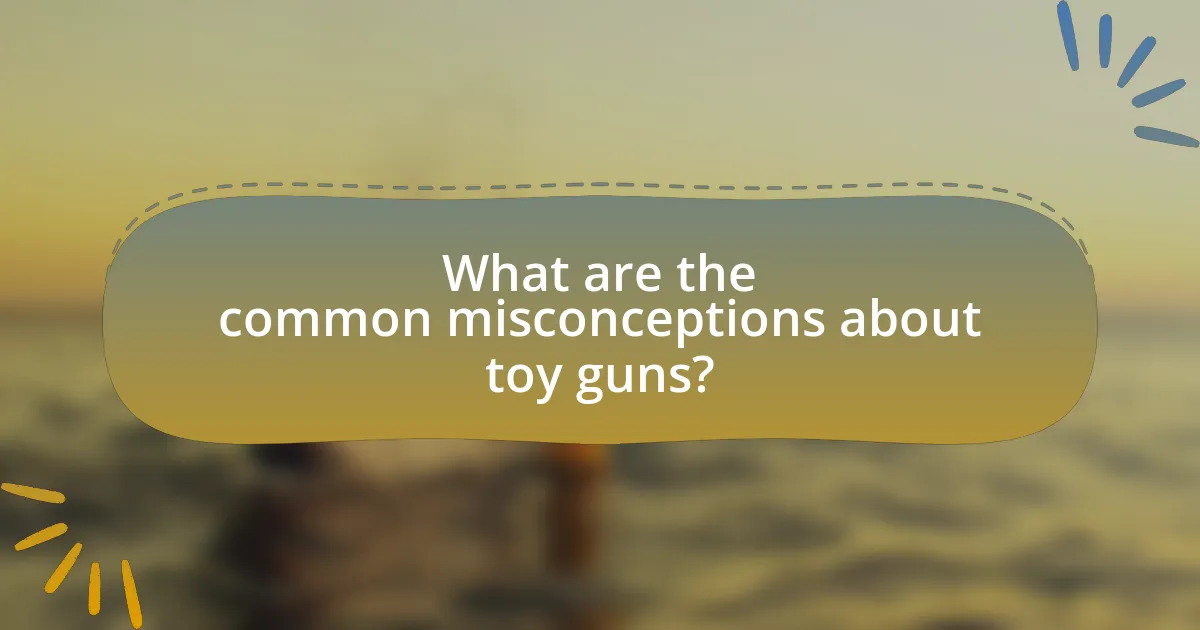
What are the common misconceptions about toy guns?
Common misconceptions about toy guns include the belief that they are entirely harmless and that they do not contribute to aggressive behavior in children. Many people assume that because toy guns are not real firearms, they pose no risk of injury or psychological impact. However, studies indicate that children who frequently play with toy guns may develop desensitization to violence and aggression, as noted in research published in the journal “Pediatrics” by researchers such as Dr. Dimitri Christakis. Additionally, there is a misconception that all toy guns are easily distinguishable from real guns; in reality, some toy guns can closely resemble actual firearms, leading to dangerous misunderstandings in public settings.
Why do some people believe toy guns are harmless?
Some people believe toy guns are harmless because they perceive them as mere playthings that do not pose any real threat. This belief is often reinforced by cultural norms that associate play with innocence and imagination, leading to the assumption that toy guns are simply tools for creative expression. Additionally, studies indicate that children often understand the difference between real and toy weapons, which can contribute to the perception that toy guns are safe. For instance, research published in the journal “Child Development” found that children as young as three can differentiate between real and pretend play, suggesting that their understanding mitigates concerns about safety.
What evidence contradicts the belief that toy guns pose no risk?
Evidence contradicting the belief that toy guns pose no risk includes incidents where toy guns have been mistaken for real firearms, leading to tragic outcomes. For example, in 2014, Tamir Rice, a 12-year-old boy, was shot by police in Cleveland while holding a toy gun that resembled a real firearm. This incident highlights the potential dangers associated with toy guns, as they can create confusion in high-stress situations. Additionally, studies indicate that children may not fully understand the distinction between toy guns and real guns, increasing the likelihood of accidents. Research published in the journal “Pediatrics” found that children often engage in play that mimics real-life scenarios, which can blur the lines between reality and play, further supporting the argument that toy guns can pose significant risks.
How can parents address these misconceptions with their children?
Parents can address misconceptions about real and toy guns by engaging in open discussions with their children about the differences between the two. This involves explaining the functionality, purpose, and potential dangers of real guns compared to the harmless nature of toy guns. Research indicates that children often struggle to differentiate between real and toy weapons, which can lead to dangerous situations (American Academy of Pediatrics, 2018). By using visual aids, such as pictures or videos, and providing hands-on demonstrations, parents can reinforce the distinctions. Additionally, parents should encourage questions and provide clear, age-appropriate answers to foster understanding and safety awareness.
How do cultural attitudes towards guns affect children’s perceptions?
Cultural attitudes towards guns significantly shape children’s perceptions by influencing how they view firearms and their associated risks. In cultures where guns are normalized and seen as symbols of freedom or protection, children may perceive them as toys or objects of fascination, leading to desensitization towards violence. Conversely, in cultures that emphasize gun control and safety, children are more likely to view guns as dangerous and to understand the importance of responsible handling. Research indicates that children exposed to gun violence in media or their environment are more likely to develop aggressive behaviors and a distorted understanding of gun use, highlighting the impact of cultural narratives on their perceptions.
What impact does media representation of guns have on children?
Media representation of guns significantly influences children’s perceptions and behaviors regarding firearms. Exposure to guns in media can normalize their use, leading children to view them as toys or symbols of power rather than dangerous weapons. Research indicates that children who frequently see guns in movies or video games are more likely to exhibit aggressive behaviors and desensitization to violence. For instance, a study published in the journal “Pediatrics” found that children exposed to violent media content were more likely to engage in aggressive play and had a diminished understanding of the real-life consequences of gun violence. This underscores the importance of guiding children’s media consumption to foster a clear distinction between real and toy guns.
How can parents counteract negative influences from culture and media?
Parents can counteract negative influences from culture and media by actively engaging in discussions about the content their children consume. This involves setting clear boundaries on media exposure, such as limiting screen time and selecting age-appropriate programming. Research indicates that children who have parents who discuss media content are better equipped to critically analyze messages and differentiate between reality and fiction. For instance, a study published in the Journal of Communication found that parental mediation significantly reduces the impact of violent media on children’s behavior. Additionally, parents can model positive behaviors and values, reinforcing the distinction between real and toy guns through open conversations about safety and responsibility.
What practical tips can parents use to reinforce the lessons learned?
Parents can reinforce lessons about the difference between real and toy guns by engaging in open discussions about gun safety and the potential dangers of real firearms. Regularly explaining the differences in appearance, weight, and function between real guns and toy guns helps children understand the seriousness of the topic. Additionally, parents can use role-playing scenarios to demonstrate appropriate responses when encountering real guns, emphasizing the importance of not touching them and seeking help from an adult. Research indicates that children retain information better when it is presented in a practical context, making these interactive methods effective for learning.
How can role-playing scenarios help children understand gun safety?
Role-playing scenarios can significantly enhance children’s understanding of gun safety by providing them with practical, hands-on experiences that illustrate the consequences of gun use. Through these scenarios, children can engage in simulated situations where they learn to recognize the differences between real and toy guns, understand the importance of not touching firearms, and practice safe behaviors in a controlled environment. Research indicates that experiential learning, such as role-playing, is effective in reinforcing safety messages, as it allows children to internalize lessons through active participation rather than passive observation. This method has been shown to improve retention of safety protocols, making it a valuable tool in teaching gun safety to children.
What ongoing conversations should parents maintain about this topic?
Parents should maintain ongoing conversations about the safety implications and societal perceptions of real versus toy guns. Discussing the potential dangers of real guns, including statistics that indicate the high rates of accidental shootings involving children, reinforces the importance of understanding the difference. Additionally, conversations should address the impact of media portrayals of guns and violence, as studies show that children often mimic behaviors they observe in movies and video games. Engaging in role-playing scenarios can help children practice appropriate responses and reinforce the message that toy guns should never be treated as real weapons.
